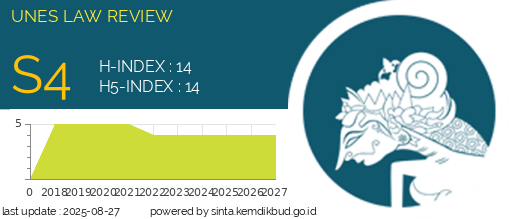Revitalisasi Pancasila: Epos dan Kontroversi di Balik Undang-Undang Cipta Kerja
DOI:
https://doi.org/10.31933/unesrev.v6i1.1183Keywords:
Revitalization of Pancasila, Job Creation Law, Indonesian Legal ControversyAbstract
This article explores the epic and controversial dimensions in the context of Pancasila Revitalization as revealed through an in-depth study of the Job Creation Law. The revitalization of Pancasila is the primary basis for responding to social and economic changes in the contemporary era, which are reflected in the latest legal reforms. Through an interdisciplinary approach, this article outlines the journey of the Pancasila Revitalization epic, revealing its critical role in shaping the national legal structure. Not only as an ideological doctrine, Pancasila is the conceptual basis for designing and implementing the Job Creation Law. However, this part of the epic also involves several controversies arising from various societal levels. The controversy discussion includes multiple perspectives, ranging from the economic impact to the social tensions. This article explores the layers of complexity that arise from the combination of the noble ideals of Pancasila and the reality of its implementation in the Job Creation Law. By highlighting crucial points, this article aims to provide a deeper understanding of the relationship between Pancasila, current legislation, and societal dynamics. In this way, readers are invited to reflect on the significance of the Revitalization of Pancasila in shaping the future direction of law and justice in Indonesia.
Downloads
References
Haryono, B. 2020. Legal Reforms and Their Impact on Pancasila: A Historical Perspective. Oxford: Oxford University Press.
Kusuma, W., and R. Setiawan. 2017. “Pancasila Ideology and Its Resilience in the Face of Legal Reforms.” Journal of Southeast Asian Legal Studies 16(3):275–95.
Prabowo, S. 2018. Challenges to Pancasila Values in Contemporary Indonesia. London: Yale University Press.
Prasetyo, H. 2019. Dinamika Hukum Di Era Reformasi: Implementasi Undang-Undang Cipta Kerja. Yogyakarta: Gadjah Mada University Press.
Pratama, R., and B. Santoso. 2020. “Controversies Surrounding the Implementation of the Omnibus Law: A Legal Perspective.” Indonesian Journal of Legal Studies 15(3):210–30.
Rahayu, L., and A. Susanto. 2018. “Legal Pluralism and the Impact on Pancasila: A Case Study of the Omnibus Law.” Indonesian Legal Review 22(2):178–95.
Santoso, D. 2017. Omnibus Law and Its Socio-Legal Ramifications on Indonesian Society. London: Harvard University Press.
Soeharto, A. 2021. Pancasila: Ideals and Realities in Modern Indonesia. Jakarta: Jakarta Press.
Soepomo, S. 2020. Pancasila: Pilar Ideologi Negara Kesatuan Republik Indonesia. Jakarta: Pustaka Alvabet.
Sudarsono, A. B., and J. Wibowo. 2021. “Revitalizing Pancasila: A Critical Analysis of the Impact of the Omnibus Law on Indonesian Socio-Legal Landscape.” Journal of Law and Society 25(2):123–45.
Wahid, A. 2017. Menyimak Pembaharuan Hukum Pidana Di Indonesia. Jakarta: Rajawali Pers.
Widodo, A. (Ed. .. 2018. Pancasila Dan Pendidikan Kewarganegaraan: Refleksi Dan Implementasi Di Era Global. Surabaya: Kencana Prenada Media Group.
Widodo, J. 2019. The Evolution of Indonesian Law: From Independence to the Omnibus Law. Cambridge: Cambridge University Press.
Winarto, S., and D. Utomo. 2022. “Pancasila in the Face of Legal Reform: Challenges and Opportunities.” Journal of Legal and Societal Issues 30(1):45–65.
Downloads
Published
How to Cite
Issue
Section
License
Hak cipta :
Penulis yang mempublikasikan manuskripnya di jurnal ini menyetujui ketentuan berikut:
- Hak cipta pada setiap artikel adalah milik penulis.
- Penulis mengakui bahwa UNES Law Review berhak menjadi yang pertama menerbitkan dengan lisensi Creative Commons Attribution 4.0 International (Attribution 4.0 International CC BY 4.0) .
- Penulis dapat mengirimkan artikel secara terpisah, mengatur distribusi non-eksklusif manuskrip yang telah diterbitkan dalam jurnal ini ke versi lain (misalnya, dikirim ke repositori institusi penulis, publikasi ke dalam buku, dll.), dengan mengakui bahwa manuskrip telah diterbitkan pertama kali di Jurnal UNES Law Review.



















